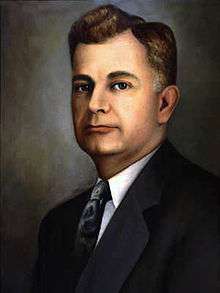Louisiana gubernatorial election, 1948
| | |||||||||||||||||||||||
| |||||||||||||||||||||||
| |||||||||||||||||||||||
| |||||||||||||||||||||||
| Elections in Louisiana |
|---|
 |
|
|
|
The Louisiana gubernatorial election of 1948 was held in two rounds on January 20 and February 24, 1948. Like most Southern states between Reconstruction and the civil rights era, Louisiana's Republican Party was virtually nonexistent in terms of electoral support. This meant that the two Democratic Party primaries held on these dates were the real contest over who would be governor. The 1948 election saw the defeat of Louisiana's reformer "anti-Long" faction and the election of Earl Kemp Long to his first full term as governor.
Under Louisiana's constitution, incumbent governor Jimmie Davis could not succeed himself in a consecutive term. Instead, Louisiana's reformer and anti-Long faction supported Sam H. Jones, who had been governor from 1940 to 1944. Jones was endorsed by outgoing Governor Davis and high-profile Louisiana politicians, such as Senator John H. Overton and Mayor deLesseps Story Morrison, Sr., of New Orleans, who controlled the city's powerful Crescent City Democratic Association. Jones's reform campaign was weakened by reminders of unethical deals and heavy-handed political tactics in his previous term and by the electorate's lack of enthusiasm for reform governors after eight years.
Sam Jones's main opponent was Long, who had been governor in 1939–40 and the inheritor of his brother Huey Long's Longite political faction. Funded by politicians, oil and gas money, and contributions from organized crime in the New Orleans area, Long ran a theatrical and entertaining campaign, making stump speeches that were a mix of political harangue and humorous anecdotes. His platform called for the elimination of Jones's civil service, the doubling of state spending on programs like pensions, school lunches, charity hospitals and asylums, new trade schools, pay increases for teachers, an increased homestead tax exemption, and bonuses for veterans of World War II. Through payoffs and promises of support, Long managed to gain the backing of powerful former enemies, State Senator Dudley LeBlanc, former Governor Jimmie Noe, and U.S. Representative F. Edward Hebert of Louisiana's 1st congressional district.
Other candidates in the 1948 election included Robert F. Kennon, a judge and former mayor of Minden who ran third in the balloting, mostly from supporters in North Louisiana and from some reformers disillusioned with Jones; and Jimmy Morrison, (no relation to Mayor Morrison) the Sixth District Congressman from Hammond who was supported by former New Orleans mayor Robert Maestri and his Old Regular political machine and finished in fourth place. Morrison served in Congress until his defeat by John R. Rarick in the 1966 Democratic primary runoff.
In the runoff, the Old Regulars threw their support behind Long. Now that his longtime enemies were supporting Long, Mayor Morrison stepped up his campaigning for Jones and began a feud with Long that would last until Long's death in 1960.
Results of first primary
| Candidate | Votes received | Percent |
|---|---|---|
| Earl K. Long | 267,253 | 41.51% |
| Sam H. Jones | 147,329 | 22.88% |
| Robert F. Kennon | 127,569 | 19.81% |
| Jimmy Morrison | 101,754 | 15.80% |
Jimmy Morrison was able to carry East Baton Rouge and several parishes in vicinity of his home region. Kennon won Shreveport's Caddo Parish and attracted some support in the rest of northern Louisiana. Support from deLesseps Morrison's machine allowed Jones to win in New Orleans, and respectable support from sections of the rest of the state sent him into the runoff round with Long. But Long's victories in most parishes in both northern and southern parts of the state gave him a commanding lead going into the second round.
Results of second primary
| Candidate | Votes received | Percent |
|---|---|---|
| Earl K. Long | 432,528 | 65.88% |
| Sam H. Jones | 223,971 | 34.12% |
The runoff election saw Long elected to the governor's office with an overwhelming majority. Of Louisiana's 64 parishes, only East Baton Rouge and West Feliciana went for Jones. Jones even lost his home base of Calcasieu Parish. He did not seek the governorship again.
Once in office, Earl Long moved to place President Harry S. Truman on the Louisiana ballot in 1948. The Democrats ran an elector slate in the state committeed to then South Carolina Governor Strom Thurmond. Had Long not intervened, Truman would not have been on the Louisiana ballot. Thurmond, as the official Democratic nominee, won Louisiana's ten electoral votes.
| Preceded by 1944 gubernatorial election |
Louisiana gubernatorial elections | Succeeded by 1952 gubernatorial election |
Sources
Michael L. Kurtz and Morgan D. Peoples. Earl K. Long: The Saga of Uncle Earl and Louisiana Politics, 1990.
Louisiana Secretary of State. Compilation of Primary Election Results of the Democratic Party of the State of Louisiana, 1948.

